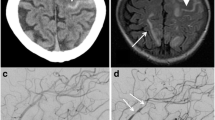Summary
Immunofluorescence studies showed the presence of IgM and/ or C3 in the endothelium of intracranial aneurysms in 5 out of 6 patients with subarachnoid haemorrhage (SAH). In none of them were the immune deposits found in the gyrus rectus. Cortical tissue of 4 epileptic patients which served as a control give negative results. Serum studies on femoral artery wall used as an antigenic substrate did not reveal circulating antibodies of the IgM or IgG class.
Our studies strongly suggest that the IgM and/or C3 immune deposits located in the endothelium of intracranial arteries may play a role in post SAH neurological complications.
Similar content being viewed by others
References
Beutner EH, Kumar V, Krasny SA (1987) Defined immunofluorescence in immunodermatology. In: Beuther EH, Chorzelski TP, Kumar Vet al (eds) Immunopathology of the skin, 3rd Ed. John Wiley, New York, pp 3–40
Chyatte D, Sundt TM Jr (1984) Response of chronic experimental cerebral vasospasm to methylprednisolone and dexamenthasone. J Neurosurg 60: 932–936
Chorzelski T, Kuch J (1969) Atypical myocardial infarction in a case of pemphigus in the light of immunofluorescence studies. Clin Exp Immunol 4: 691–695
Findlery JM, Weív BKA, Kanamaru K, Espinosa F (1989) Arterial wall changes in cerebral vasospasm. Neurosurgery 25:736–746
Grabar P (1983) Autoantibodies and the physiolgical role of immunoglobulins. Immunol Today 4: 337–340
Handa Y, Hayashi M, Takeuchi H, Kobayashi J, Kawano H (1990) Effect of immunosuppressive drugs in the development of cerebral vasospasm after subarachnoid hemorrhage in primates. In: Sano K, Takamura K, Kassell NF, Sasaki T (eds) Proceedings of the 4th International Conference on Cerebral Vasospasm. University of Tokyo Press, Tokyo, pp 379–381
Handa Y, Hayashi M, Takeuchi H, Kabayashi H, Kawano H, Kabuto M (1991) Effect of cyclosporine on the development of cerebral vasospasm in a primate model. Neurosurgery 28: 380–386
Handa Y, Kabuto M, Kobayashi H, Kawano H, Takeuchi H, Hayashi M (1991) The correlation between immunological reaction in the arterial wall and the time course of the development of cerebral vasospasm in a primate model. Neurosurgery 28: 542–549
Hoshi T, Shimizu T, Kito K, Yamasaki N, Takahashi K, Takahashi M, Okada T, Kasuya H, Kitamura K (1984) Immunological study of late cerebral vasospasm in subrachnoid hemorrhage. Detection of immunoglobulins, C3, and fibrinogen in cerebral arterial walls by immunofluorescence method. Neurol Med Chir (Tokyo) 24: 647–654
Hunt J, Kassell N, Pertuiset B, Sano K, Teasdale G, De Villiers JC, Drake CG (1988) Report of the World Federation of Neurological Surgeons Committee on a universal subarachnoid hemorrhage grading scale. J Neurosurg 68: 985–986
Jennett B, Bond M (1975) Assessment of outcome after severe brain damage. A practical scale. Lancet 1: 480–484
Kuch J, Chorzelski T (1968) Immunofluorescence studies in recent myocardial infarction. Pol Arch Med Wewn 41: 729–737
Logtenberg T (1990) Properties of polyreactive natural antibodies to self and foreign antigens. J Clin Immunol 10: 137–140
Ostergaard JR, Kreistensen, BO, Svehag SE, Teisner B, Miletic T (1987) Immune complexes and complement activation following rupture of intracranial saccular aneurysm. J Neurosurg 66: 891–897
Pelletieri L, Carlsson CA, Lindholm L (1981) Is the vasospasm following subarachnoid hemorrhage an immunoreactive disease? Experientia 37: 1170–1171
Pelletieri L, Nilsson B, Carlsson CA, Nilsson U (1986) Serum immunocomplexes in patients with subarachnoid hemorrhage. Neurosurgery 19: 767–771
Peterson JW, Kwun B, Nishizawa S, Hackett JD, Zervas NT (1988) Immunoreactivity, immunosuppression, and cerebral vasospasm following SAH. Stroke 19: 132
Peterson J, Nishizawa S, Teramura A, Candia G, Bun T, Spanes A, Zervas N (1990) Calmodulin—antagonism and immunosupression in cerebral vasospasm. In: Sano K, Takakura K, Kassell NF, Sasaki T (eds) Proceedings of the 4th International Conference of Cerebral Vasospasm. University of Tokyo Press, Tokyo, pp 375–378
Peterson JW, Nishizawa S, Hackett JD, Bun T, Teramura A, Zervas NT (1990) Cyclosporine A reduces cerebral vasospasm after subarachnoid hemorrhage in dogs. Stroke 21: 133–137
Ryan US (1989) Keynote address: active function of the endothelium. In: Ginsberg MG, Ditrich WD (eds) Cerebrovascular diseases. Raven Press, New York, pp 1–15
Ryba M, Pastuszko M, Iwańska K, Koziarski A (1989) Immunological method for prevision of the progress in neurological deficit in patients with intracranial aneurysm rupture. Acta Neurochir (Wien) 97: 67–70
Ryba M, Pastuszko M, Bidziński J, Iwańska K, Dziewięcki C (1990) Immunosuppressive treatment reduces the neurological deficit after early clipping of ruptured aneurysm. In: Sano K, Takakura K, Kassell NF, Sasaki T (eds) Proceedings of the 4th International Conference on Cerebral Vasospasm. University of Tokyo Press, Tokyo, pp 382–384
Ryba M, Iwańska K, Walski M, Pastuzko M (1991) Immunomodulators interfere with angiopathy but not vasospasm after subarachnoid haemorrhage in rabbits. Acta Neurochir (Wien) 108: 81–84
Ryba M, Grieb P, Bidziński J, Pastuszko M, Dziewięcki C, Iwanska K (1991) Cyclosporine A for prevention of neurological deficit following subarachnoid hemorrhage in humans. Stroke 22: 531
Ryba M, Pastuszko M, Bidziński J, Iwańska K, Dziewięcki C (1991) Cyclosporine A prevents neurological deterioration of patients with SAH—a preliminary report. Acta Neurochir (Wien) 112: 25–27
Sano K, Saito J (1978) Timing and indication of surgery for ruptured intracranial aneurysms with regard to cerebral vasospasm. Acta Neurochir (Wien) 41: 49–60
Smith RR, Clower BR, Honma Y, Cruse JM (1988) The constrictive angiopathy of subarachnoid hemorrhage: an immunopathological approach. In: Wilkins RH (ed) Cerebral vasospasm. Raven, New York, pp 247–252
Soltenburg-Didinger G, Schwarz K (1986) Brain lesions secondary to subarachnoid hemorrhage due to ruptured aneurysms. In: Cervos-Navarro J, Klatzo I, Plum F (eds) Brain microcirculation, pathology, diagnosis, therapy. An Erwin-Riesch Symposium Institute of Neuropathology, Brain, September 2–5, pp 87–91
Author information
Authors and Affiliations
Rights and permissions
About this article
Cite this article
Ryba, M., Jarząbek-Chorzelska, M., Chorzelski, T. et al. Is vascular angiopathy following intracranial aneurysm rupture immunologically mediated?. Acta neurochir 117, 34–37 (1992). https://doi.org/10.1007/BF01400632
Issue Date:
DOI: https://doi.org/10.1007/BF01400632




